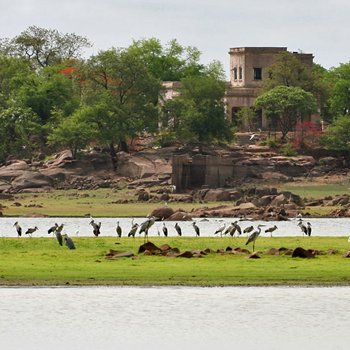Discover Pocharam Wildlife Sanctuary: Rich Biodiversity and Serene Landscapes

The Pocharam Wildlife Sanctuary, once the favored hunting grounds of the Nizams, extends over an area of 129 sq. km and is rich in diverse flora and fauna.
Established in 1952, the sanctuary is named after the picturesque Pocharam Lake, created by the construction of the Pocharam Dam on the River Allair from 1916 to 1922. The sanctuary, covering an area of 130 sq. km, was designated as a wildlife sanctuary in the early 20th century.
Adjacent to the sanctuary is a reservoir that attracts various bird species, including the painted stork, bar-headed goose, Brahminy duck, and more. It is also home to an array of animals such as the sambar, Nilgai, leopard, forest cat, sloth bear, wild dog, wolf, and jackal.
The sanctuary offers surreal beauty and unparalleled tranquility, making it an ideal retreat from the hectic urban life. Encompassed by lush forests, it hosts numerous species, including the Brahminy Buck, Chinkara, Four Horned Antelope, and various birds such as peacocks, black and white ibises, herons, and spoonbills. Pocharam Wildlife Sanctuary is a haven for nature enthusiasts, wildlife watchers, and bird lovers alike. It also features a thrilling 4.5 km trekking trail that winds through dense forest and marshlands.
FAQs:
What is the significance of Pocharam Wildlife Sanctuary in Telangana?
Pocharam Wildlife Sanctuary, established in 1952, spans 129 sq. km and is renowned for its diverse flora and fauna. It was once a favored hunting ground of the Nizams and is named after the scenic Pocharam Lake, formed by the Pocharam Dam.
What wildlife can be spotted at Pocharam Wildlife Sanctuary?
The sanctuary hosts a variety of animals including sambar, Nilgai, leopard, sloth bear, wild dog, and a rich birdlife featuring species like the painted stork, Brahminy duck, and more. It's a paradise for nature enthusiasts and birdwatchers.
What activities can visitors enjoy at Pocharam Wildlife Sanctuary?
Visitors can indulge in trekking along a 4.5 km trail that winds through dense forests and marshlands, offering breathtaking views and opportunities to observe wildlife in their natural habitat.